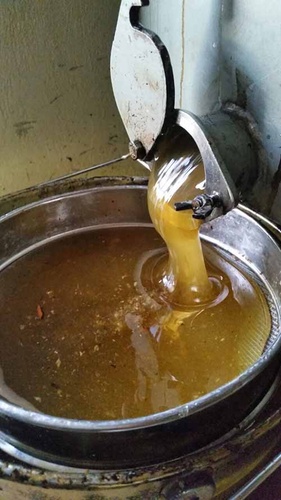Honey
All the scents of the aromatic herbs and plants of the region are gathered in the honey produced in Mani. There are three kinds of honey: thyme honey, floral honey and sage honey. Thyme honey is characterized by its rich and full flavour. Floral honey or “Maitiko” (honey of May), as it is called in Mani, carries aromas of flowers that give it an excellent taste. Finally, sage honey is the most pungent of all Greek honeys with a particularly bitter sweet taste.
The rich flora of Mani, characterized by a variety of wild aromatic and other plants, contributes to a good quality product. Wildflowers and herbs like oregano, sage and, most of all, thyme give the honey produced in this region its unique flavour and amber colour.
With pollen as the basic food for bees, the Northern Mani region especially favours the beekeeping industry. The good climate of Mani has always greatly facilitated flowering, offering large amounts of pollen. It seems that in the early 19th century, the quantities of honey produced in the area were big enough to support trading of the product both inside and outside Greece. In the past, honey was taxed in Mani. Both Venetians and Turks taxed honey producers in Passava with the so-called “beehive tax” and “melissiatiko” respectively. You must definitely try the traditional sweets of Mani: pasteli, a sort of nougat made with sesame and honey, and folds, both with excellent flavours!
Did you know that…?
Polemika Melissia is a historic area of Mani known for its towers, many of which are still standing. Built with local materials, they are in perfect harmony with the landscape. The towers of Mani are considered to have been there since the Byzantine period. They were used as dwellings and their architecture served the purpose of defending the area against intruders. In some cases, the towers were as high as 20 metres. The height of the tower was directly proportional to the social status of the owner.
The people in Mani managed to transform their towers into fortresses. To ensure their defense, the towers had small windows, “toufekotrypes”, hollow spaces through which they could fire, oil smelters and cylindrical stones instead of doors.
The residents were very inventive and took advantage of every inch of their towers. In some towers there were special places for clay beehives. In times of peace, beehives offered them the honey they needed, while in times of war or unrest, they were a valuable ally against the enemy. Clay beehives were removed and hurled from the tower down against besiegers, who had to deal with bee stings as well as the blows from the beehives, a combination that was often lethal. The name “Polemika Melissia”, meaning “military beehives”, refers to beehives used as a weapon.
There have been reports of military attacks with venomous insects since the Neolithic period and the times of the Old Testament. That was a type of biological defense warfare, during which combatants used the natural forces of animals, in the case of Mani of bees, to defend themselves against the enemy.
The use of “polemika melissia” was such a tactic. It did not exactly result in the immediate annihilation of the enemy but had mainly psychological effects; it surprised the enemy, maximized their suffering, and made them lose morale.
This legendary tactic was developed during the Middle Ages, when beehives were hurled against enemies with the use of catapults.
- Honey is a powerful natural antiseptic.
- Add honey to the juice of one lemon and drink to get rid of persistent cough.
- Honey is a source of high nutritional value. Besides the sugar it contains, it facilitates the absorption of calcium and, generally, of active ingredients in the body.


